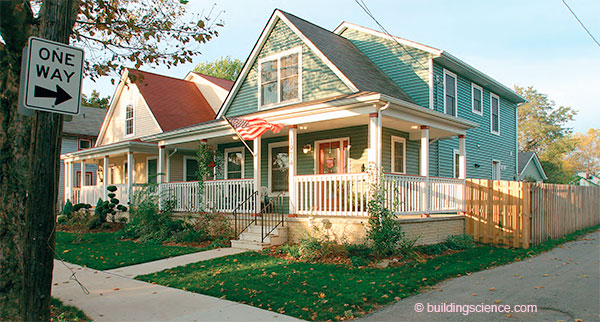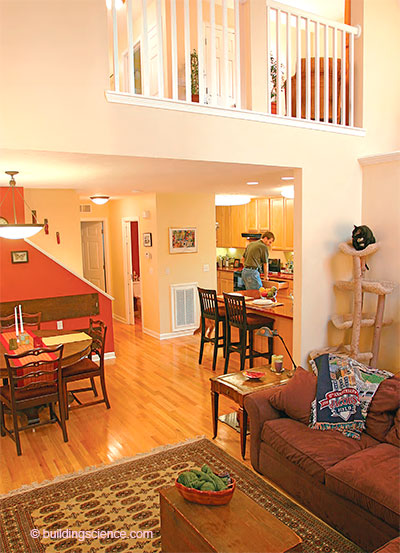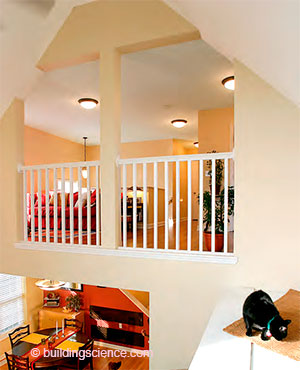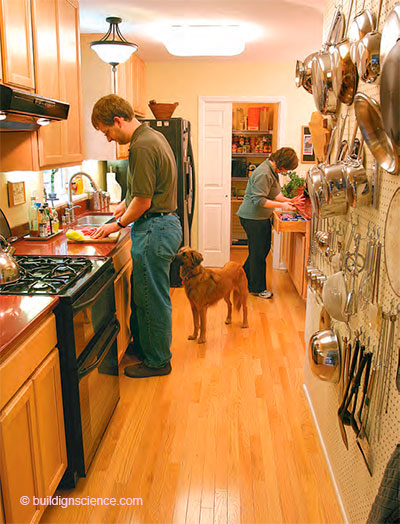Think $50 per square foot and $50 a month for utilities are unattainable? Government-sponsored research proves otherwise. Reprinted with permission from Fine Homebuilding, June/July 2005, pages 56-61.
Many architects, builders, and consumers are in denial about the true cost of a house. Beyond the price tag, there are operating and maintenance costs. Indirectly, there are ecological and political costs.
The U.S. Department of Energy's Building America program (sidebar facing page) uses a team-design strategy to identify trade-offs that make houses less expensive to build as well as less expensive to own. The homes that my firm designs and builds, such as the one featured here, are not only affordable but also feature materials and construction details that create healthful living conditions. And the benefits of a small house that's built right extend beyond the homeowner's checkbook.

Infill houses benefit family, community, and planet
An excellent way to reduce construction costs is to take advantage of existing sewer, water, electricity, and roads. Often overlooked, vacant lots or vacant houses can be diamonds in the rough, keeping property taxes low, cutting the commute, and providing a few more customers for the family-owned corner store. Because infill lots are a particular size and shape, they force compact design. You need to make the best use of the footprint you get. But utilizing infill lots isn’t always easy.
Demolition of abandoned houses often involves dealing with toxic materials such as lead and asbestos, and disposing of these materials can be tricky in some cities. Also, existing soils may need to be stabilized before new foundations go in. The trade-off is generally worth it: Infill projects help to revitalize neighborhoods, at the same time reducing development pressure outside the city.
Look for design trade-offs
The key concept in our team-design strategy is finding trade-offs. We realize that a cube has six sides, and that the more time and money we spend on the outside of the cube, the less we’ll spend on the equipment needed to condition the inside. Some of the trade-offs we incorporate have a five-year payback (such as a more efficient water heater and furnace), so they’re no-brainers. Other trade-offs are more qualitative than quantitative, like the living room’s vaulted ceiling.


High-performance windows (and thoughtful placement of those windows) can decrease a house’s cooling costs. Better insulation details can cut heating costs.
Another trade-off is in our siding choice. We strongly advocate what we call a vented siding assembly on exterior walls, which incorporates a drainage plane behind the siding. By providing an exterior escape route for water that gets behind the siding, we protect the wall assembly from moisture damage. Installing furring strips or a drainage mat behind wood or fiber-cement siding is one way to create a vented siding assembly. But for affordable housing, our siding choice is vinyl. Vinyl siding has a built-in drainage system. Low up-front cost, durability, and zero maintenance are other advantages. When installed well, vinyl can look very good.
Form still should follow function
A box is the most efficient use of materials, and it is the most affordable shape to build. But it doesn’t have to be boxy. The design featured here has morphed a number of times from the prototype, but it’s basically the same floor plan. The major change was in the roof design. The prototype used many dormers to boost living space on the second floor while giving a compact, 1-1/2-story appearance from the street. But a roof with many dormers is hard to vent properly, and it’s time-consuming to build. My solution was to keep the 1-1/2-story look at the front gable end, then 10 ft. back into the house raise up to a second story. This way, we’re able to use trusses for the majority of the roof, maximize usable space on the second floor, and keep the quaint curb appeal of the front by running the eaves down to the first-floor walls.
Built right means healthy homeowners
Many systems that we incorporate into a house for energy-efficiency and affordability have the added benefit of creating a healthful space for the folks who live there.
We use three methods to keep inside air clean: source control of pollutants, dilution of indoor air with outdoor air, and filters in the air handler. We avoid wall-to-wall carpeting because it can act as a habitat for dust mites and other allergens. Instead, we use wood or tile flooring. Paint should have low volatile organic compounds (VOCs), and furniture should be made with solid wood rather than particleboard, which can outgas. These examples demonstrate pollutant source control.
Bringing outside air into the air handler dilutes indoor air, which can become stale in tight houses. Odors from indoor pollutants such as pets and poisons need to be flushed periodically. Combustion appliances that burn their own exhaust and durable construction details that deter bugs, mold, and rot improve air quality in houses.

A galley kitchen with elbow room. This straight-ahead layout uses space efficiently and provides room for two cooks and a hopeful onlooker. The pegboard wall can’t be beat as economical, versatile storage space.
Safeguards such as these make Building America houses certified healthy houses, which are affordable the day you buy them and every day afterward. . .
Download complete document here.
